Round wood timber framing - introduction
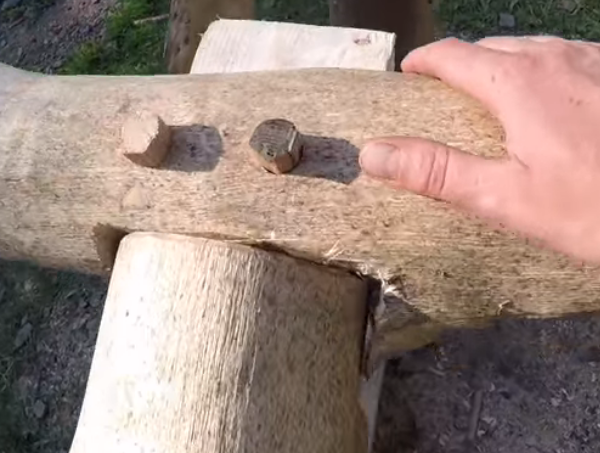
“Our fast-growing softwoods are often neglected because there is no longer adequate commercial value to justify thinning or felling them. Left to their own devices, they grow close together in light-deprived plantations that pull the long, straight poles skyward. These are perfect for roundwood timber-framing.” – Maddy Harland
Contents
What is round wood timber framing?
First the round wood part – round wood is straight from the tree (with or without bark), without any processing, squaring or planking. Timber framing is creating the structural framework for a building from wood. The frame bears the load, then the walls are filled in with something else, which could be timber cladding, straw bales, wattle & daub, or bricks and mortar.

Traditional timber framing uses mortice and tenon joints secured with wooden pegs and wedges, all of which is traditionally done with hand tools (although commercial timber framers now use power tools). Mortice and tenon joints are female / male. The mortice is a slot, and the tenon fits into the slot. Then a hole is drilled straight through the joint, into which fits a peg.
There are different types of pegs: a tapered peg wedges itself into the hole; the peg could be untapered and octagonal, so that the corners make the diameter of the peg slightly larger than the hole, and it locks itself into the wood when it is hammered in; the peg could just be round; it could be wedged in; or there could be wedges in the end of the joint.
In square timber framing, the hole could be offset – a hole is first drilled through the mortice, the tenon is put in, a mark is made through the hole onto the tenon, and then it is offset a few mm, so that when the peg is hammered in with a wooden mallet, the offset holes get pulled together by the peg, the shoulder of the tenon gets pulled up tight against the mortice joint, and you don’t need wedges. Round wood timber framing doesn’t use this method so often however.

Round wood timber framing is an older technique than square timber framing. The history of timber building goes something like this:
- lean-tos – timbers stay up by leaning on each other, and aren’t fixed at all
- timbers lashed together – tipis evolved from this, as did basic shelters all over the world (knotting pre-dates stone tools and the use of fire; anthropologists have even recorded gorillas using basic knots in their nests)
- metal tools were developed in the iron age, and jointing took off – people started experimenting with squaring timbers with axes, plus square joints
- later, saws were invented, and round trees were sawn into square timbers

Simultaneously, the log cabin model was being used in Scandinavia. This doesn’t involve making a frame, but building a load-supporting structure from the ground up by interlocking logs. In Britain, the classic timber framing style was cruck frames – triangles of round wood pegged together to make an A shape. They can still be found in old barns and cottages. But they had to find very long pieces of wood, so people started making small squares and building them up to the right shape, then joining the squares diagonally to make a roof.
By now, everyone was squaring their timber, because a) it’s more uniform, and removes uncertainty; b) all joints can be almost identical – you don’t have to take into consideration the shape of the tree; unskilled people can then be employed to make standard joints; and c) right-angles fit better, joints become stronger, and you can fit bricks / wattle & daub in more easily. Everything is flat and flush.
What are the benefits of round wood timber framing?
So round wood could be considered old-fashioned, but the reasons for resurrecting it are aesthetic and ecological. It looks pretty; it’s a natural antidote to the square, flat, generic world that we build; it reconnects people with the forms of the natural world that are more relaxing to the eye; and it reminds us that wood comes from trees.

Also, you can use coppiced wood and smaller dimension timber. If you use squared wood, you need to cut down mature trees and re-plant, but a coppiced tree continually re-grows. Plus round wood cuts out the enormous industrial process of squaring timbers. People can use their own local woodlands to build with – it doesn’t have to go off to a factory to be processed, and you don’t have to get a mobile miller in, which saves a lot on transport, energy and associated emissions.
Round wood is 50% stronger than similar-sized squared timber, hence you need a smaller cross-section of round wood to do the same job, which saves wood.

Any kind of traditional timber framing has a structural advantage if the joints are made of wood; in a fire, joints held together with metal fail more quickly because metal conducts heat into the centre of the timbers – so your house will fall down more readily.
And finally, round wood timber framing has all the benefits of timber building – using wood is natural, renewable, biodegradable, locks up carbon and supports local woodlands.
What can I do?
Start small – round wood is suited to a project in your garden / smallholding, and lends itself to DIY. Planners won’t know what you’re talking about, but it doesn’t matter – it’s building regulations that are important. If an architect specifies it properly, it will be OK. In Ben Law’s book, The Woodland House there are figures for loadings / size of timbers, and as regards building regs.

You can cut the timber yourself, or source it from timber yards. You’ll need a basic set of green woodworking tools:
- side-axe (like a normal axe, but only has a bevel on one side, so one face is flush with the wood as you’re cutting it)
- froe (for splitting logs into lengths for making pegs)
- wedges and mallets (for splitting)
- shave horse and draw knife (for making pegs)
- rounder – like a large pencil-sharpener for pegs, or a dowel-maker – a piece of metal with a hole in, which you bash the peg through to get it to the right shape and size
- maybe an adze or a curved chisel for scooping out parts of poles for joints
- plus a hand-auger to drill holes
- a bowsaw could be good too for cutting the timber (or you could use a chainsaw, but the greenest way to build is with hand tools)

These tools will probably cost around £200, and you can make your own shave horse on a green woodworking course. There are courses on round wood timber framing, and you can even make your own wooden roofing shingles.
NB: traditionally, oak and sweet chestnut are used if the structure is going to get wet or be in the ground, as they are the most durable. Heartwood is the durable part of the wood, so remove sapwood if it’s going to be underground or in joints that are exposed to rain.
Thanks to Adrian Leaman of Wholewoods for information.
Specialist(s)
The specialist(s) below will respond to queries on this topic. Please comment in the box at the bottom of the page.

Adrian Leaman of Wholewoods helped Ben Law to build his Woodland House in 2002, and since then has been roundwood timber framing, particularly reciprocal roof roundhouse building, and sharing woodland and woodcraft skills with people from all walks of life. He is a Forest School Leader and works with adults and teenagers on educational projects.

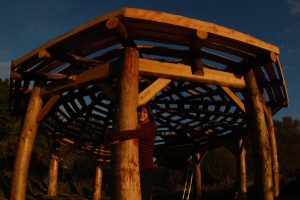
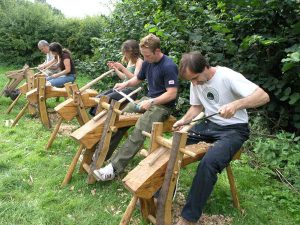
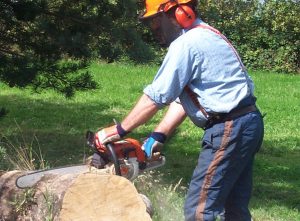
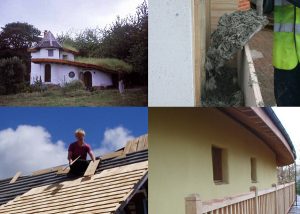

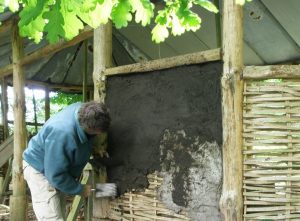

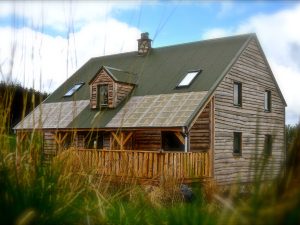
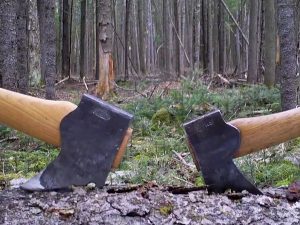
10 Comments
Please provide your source for saying that round wood is 50% stronger than squared timbers?
http://naldc.nal.usda.gov/download/38061/PDF
From the conclusion: ’round timber will have between two and four times the load capacity of any solid-sawn structural timber produced from it.’
Do you recommend building with green timber or letting it dry for several months before building?
I have always heard that green is beat. It tightens up as it dries and ages. Others may have differing opinions but I plan on trying green. Drying for several months is not material as logs take years to dry. Also dry may harder to work with.
When would you recommend debarking timbers? Also, our intention at present is to use round wood but a rather conventional timber frame, not the A-frame cruck type. Any thoughts there?
Definitely debark to keep the timber from rotting or being eaten. The sooner you do it the easier it is. Roundwood is good for all types of structures roundhouse – A frame or conventional square type building.
What do you use (if anything) as water-proofing between roof battening and shingles?
Nothing or a water proofing sheet. I don’t have a brand recommendation tho
Hi there, looking for a small scale forestry company located near London (preferably south) need to source some round wood for a decorative archway within a new tattoo studio. Thanks!
Lashing is a really strong yet flexible method of joining timber. For example, see James Wharram’s ocean going catamarans. Every wrap multiplies the strength of the connection. As a result, it doesn’t take expensive, super strong rope to hold heavy timbers under substantial load. If I were going to build with raw logs, it’s what I’d try first.